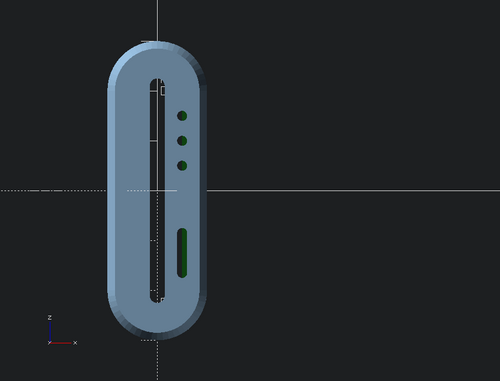NOXA
NOXA -- open pocket/wearable microserver equipped with standard mobile interfaces such as 4G-LTE/GSM, GPS, Bluetooth, and WiFi. The NOXA system fundamentally transforms the traditional smartphone experience by offering a comprehensive remote (primarily web-based) interface. This innovative approach allows users to connect to the NOXA microserver via Wi-Fi, thereby gaining access to a full-screen interface that mirrors the functionality of a conventional smartphone. This seamless integration ensures that users can interact with the NOXA system in a manner identical to how they would with a traditional "phone" device. Additionally, the user has the ability to seamlessly switch between devices and connect additional devices with wireless capabilities, creating portable wearable networks and even communicate in existed community-diven decentralized networks like Meshtastic. By establishing an SSH connection, users have complete access and the capability to install and customize the system as needed.
hadrware ver.0.1

- Onion Omega2 as a base SoC module (WiFi + microSD)
- GSM/LTE
- LoRa module (presumably based on SX1262/1268)
- GPS
- i2c (RT clock, ADC, Accelerometer...)
- i2s
- bluetooth (partially implemented)
- USB
- UART
- ethernet
- power, charging controller
- LiPo / LiFePO battery
enclosure








We are planning to create two versions of the case: 1. DIY Version: Intended for tinkers, allowing anyone to assemble their own case using readily available materials. The side panels are 3D printed using an SLA printer. The cover is cut from a sheet of Plexiglas and formed by bending it to fit. The Plexiglas cover is attached to the side panels using four screws that fit into pre-cut holes. There is also an idea to incorporate an ePaper display beneath the transparent panel. 2. Production Version: The panels will be manufactured using molding or pressing techniques, resulting in a sleek black glass case with a translucent finish. An OLED display can be optionally installed beneath the glass cover in this version. The case design is being developed using OpenSCAD, opening a wide range of possibilities for easy modifications and "patches"."
milestones
- breadboard proto
- basic GSM phone/sms functionality
- UART/GPS communication
- wireless sound transmission
- i2s, LoRa implementation
- PCB based prototype
- web interfaces / client-server integration
- software modules to enhance the coordination between all components of the system
- DIY enclosure design
- DIY prototype
- documentation and publicity
- solid design
- mesh capabilities and isolated networking
- ePaper/OLED-matrix version
f.a.q.
is it a thin client? in general yes, it is a thin client concept with some caveats why not VNC? We're aiming for a simple SoC with limited resources. The battery life is more important than the power of the microserver. That's why we deliberately refused to use powerful ARM-based SOCs like Allwinner and others (however... I'm looking at the V3s, looks very promising for the next version). If you remove the screen interface from the logic of a popular smartphone, everything else practically does not require resources. We follow the great principle of KISS. However, we don't rule out a second version based on RPi or LicheePi 4A (it even would probably be possible to connect a virtual headset!) Would I still be able to use my Androd (iPhone) if I connect to NOXA? Yes, of course, the NOXA microserver will not affect your primary device. It is an invisible add-on that allows you to separate important information from "frontend" device, as well as critical functions (including native phone calls/sms and even Network Connection infrastructire) from the 'screen device' you are interacting with. Will the browser work inside the web-view Not yet. We aim to use it as a remote communication server as well as a data server. The user can store files, contact lists, mount remote resources and communicate on NOXA, but still use the smartphone to browse the web and play games. Almost no websites work on my old smartphone. What's the point of your craft if it won't have a built-in browser? The main reasons why browsers stop working on older devices is an expired DST root certificate and JS (ECMAScript) incompatibilities. Simple proxy specifically designed to provide compatibility would solve "outdated browser problem". Implementation of such solution is in the plans of our project. I understand correctly that if I take a picture on my smartphone, the pictures stay in my smartphone as well? or...?s That depends... *nix-based systems (like Android or iOS) allow you to set up remote resources in a very flexible way. You could even mount the NOXA directory directly to your DCIM/ or sdcard/ folder on your smartphone (even without root on Android, using Termux). This way, even if you lose it, all your data stays in your pocket. Would it be possible to run full Android on NOXA microserver? This feature is not expected in the current version. However, in the next more powerful version we plan to test a full-fledged Android distribution with Remote Frame Buffer protocol (RFB) as an experiment. However, I would like to emphasize that at the moment the goal of the project is to create a simple budget device not replacing a smartphone, but first of all reusing outdated smartphones by supplementing them with a full-fledged device that extends their capabilities. What is NOXA "Noxa" is "Axon" read backwards. Except of that it's a critical protein in the regulation of apoptosis.
connect
noxa (at) evergadget.org -- direct communication noxadev (at) list.evergadget.org -- email-list (subj "subscribe" to subscribe :) We are open to all ideas!
git
coming soon! stay tuned...